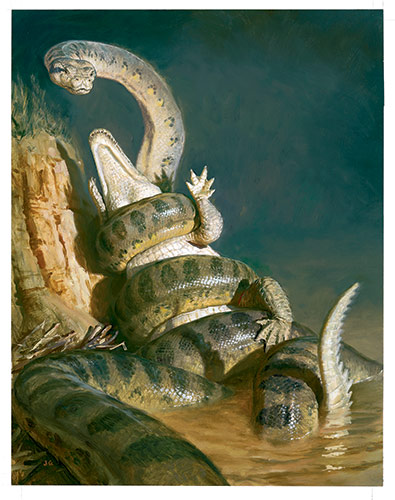Although it’s been many thousands – if not millions – of years since ancient civilizations and some extinct animal species flourished, their legacies continue to fascinate and live on through the creative vision of artist James Gurney. Welcome to Dinotopia and other lost worlds.
It was 128 years ago when — in October of 1888 — the first issue of National Geographic was published. Containing articles, illustrations, and photographs covering geography, history, world culture, and more, the magazine has inspired generations across the globe to understand the world beyond — and before — them.
One of these was artist James Gurney, who as a child would journey back in time through the illustrated pages of the magazine. “I would tiptoe into the hallway late at night” Gurney remembers, “and read about pilots in biplanes flying over uncharted Incan ruins. After school I would dig excavation pits in my suburban back yard, hoping to find a dinosaur bone or maybe even a lost temple. Even though I didn’t find much of what I imagined, I made up for it by sculpting it out of clay or drawing it on paper.”

Today, Gurney continues a similar process, working as a painter and illustrator of imagined worlds that seem factually plausible. He also paints paleoart, scientific reconstructions of actual extinct life. “Paleoart is wildlife art for the time traveler,” he says. “I’ve always been interested in creating an alternate universe that my viewers can travel to during those moments of daydreaming. My inspiration has always come from the 19th century Salon painters and the Golden Age illustrators, who used their training to breathe life into mythic adventures and historical epics.”

Gurney’s artistic vision undoubtedly developed from both his childhood experiences and his early professional career. Eventually, Gurney grew from a child reading National Geographic to an illustrator working for the magazine. He recalls, “Looking back, I suppose that illustration work was an ideal training ground for the kind of visual world I was trying to develop, because I was called upon to paint all sorts of subjects. I traveled to Jerusalem, Athens, and Rome on assignment for National Geographic. It was a huge inspiration to see those famous old cities. I spent time with Rick Bronson, an archaeologist who was just like Indiana Jones. He led me through overgrown jungles to find little-known Etruscan ruins, and we descended down ladders into newly discovered tombs. Sitting around the campfire at night, Dr. Bronson and I would talk about dreams of discovering a lost city along the lines of Machu Picchu or Troy. I realized that I could always make a painting of such a lost city, and that led to painting ‘Waterfall City: Afternoon Light.’”

Adventure seems apropos to describe Gurney’s work — one isn’t quite sure what to expect. From plein air oils, to fantasy and science, to a fantasy universe called “Dinotopia” developed in a series of New-York-Times bestselling illustrated books, Gurney’s artistic range is eclectic, impressive, and tantalizing. Exhibitions of his original artwork have traveled to over 30 art museums in the United States, England, France, Italy, and Switzerland.

The artist’s creative process can be equally varied. However, for Gurney, a typical process begins “with small thumbnail sketches in pencil, pen, or watercolor.” He says, “If it’s an architectural subject or a dinosaur, I’ll often build a little maquette to establish shadows and angles. Sometimes I’ll do a small color study or comprehensive sketch. If the painting requires scientific or historical accuracy, I consult with experts at every stage of the process and incorporate their suggestions. After all these studies, I develop a line drawing — and sometimes a full charcoal drawing — and finally begin the final painting.”
Gurney’s art has been leading him on a variety of new adventures, both on and off the canvas, and many of them are documented on his blog “GurneyJourney” and on his Instagram and YouTube channels. “I’ve kept several doors open all through my career” he says, “painting in the studio, sketching on location, teaching, writing, illustration, video production, animation, and storytelling. Lately I’ve been doing more self-publishing, particularly in the video art instruction category. I also have new story worlds that I’m developing, and I expect to continue with my blogging, which I’ve done daily since 2007.”
Here’s a fascinating look into one of Gurney’s projects in which the artist was commissioned to paint the now-extinct Pelagornis Sandersi, the largest bird in history:
To learn more, visit James Gurney.
This article originally appeared in Fine Art Today, 2017
> Sign up to receive Fine Art Today, our free weekly e-newsletter
> Click here to subscribe to Fine Art Connoisseur magazine, so you never miss an issue
> Join us for Realism Live, October 2020









